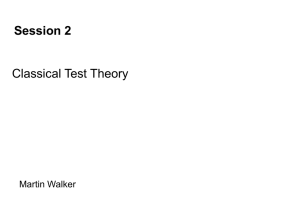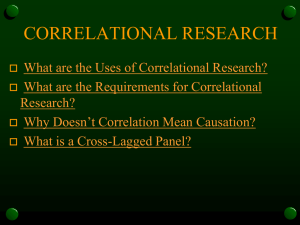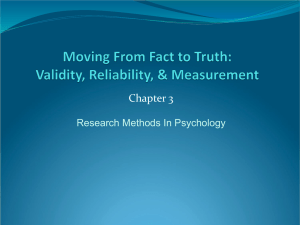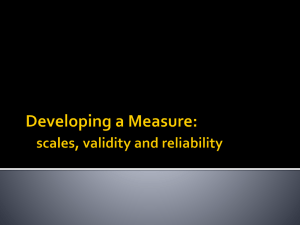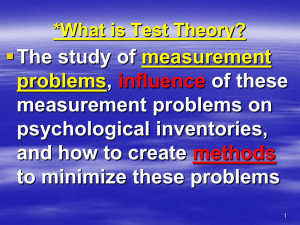group_designs
advertisement
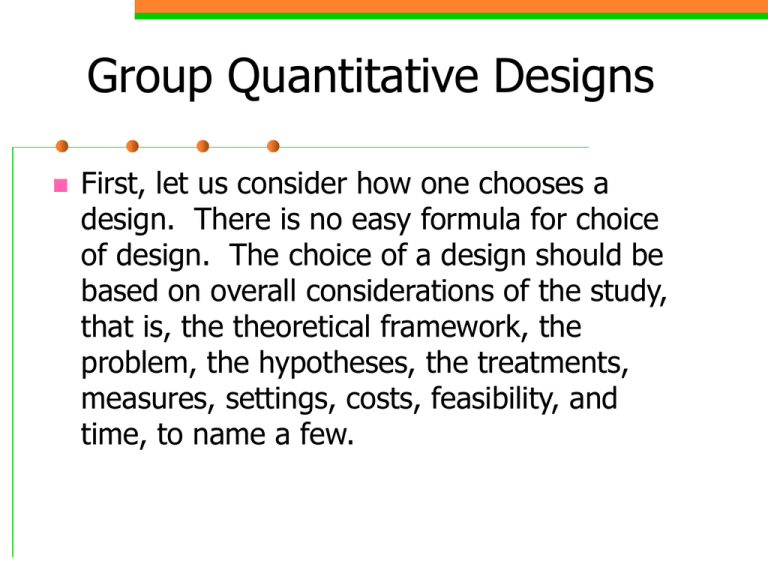
Group Quantitative Designs First, let us consider how one chooses a design. There is no easy formula for choice of design. The choice of a design should be based on overall considerations of the study, that is, the theoretical framework, the problem, the hypotheses, the treatments, measures, settings, costs, feasibility, and time, to name a few. Correlational research Assesses strength of a relationship between two or more variables. Cannot imply causality However it can: Help with prediction of future events Provide data that is consistent or inconsistent with a particular scientific theory. Correlational research can’t prove a theory, but it can disprove/negate a theory. Differential Research Methods Differential research compares 2 or more groups that are differentiated by some preexisting variable. No manipulation – only measurement. Group differences existed before the study was conducted. IV: Classification DV: Behavior measured Differential design is not the same as experimental: Differential design groups individuals by pre-existing conditions (e.g., race or gender). Experimental design groups are determined by random assignment. Causality cannot be inferred from a differential design Cross-sectional vs. Longitudinal Cross-sectional Eg: groups of individuals at different ages are examined on a particular variable Cohort Effect (e.g. living through Great Depression) Longitudinal Follow same people over time to observe developmental changes (controls for cohort effects) Artifact: an apparent effect of an independent variable that is actually the result of something else – thus a confound. Correlation Analysis Pearson product-movement correlation Spearman rank-order correlation Used if both variables are at least on an interval scale Used if one variable is ordinal and the other is at least ordinal. Range is from –1.00 (perfect negative relationship) to +1.00 (perfect positive relationship). Correlation of .00 means no relationship whatsoever. Interpretation Need to know whether the correlation is significant: p-values If the correlation is low (close to zero) then it is likely that you will not have a significant correlation. Coefficient of determination: Computed by squaring the correlation Eg: if r = .50 then r2 = .25. So a correlation of .50 indicates that 25% of the variability of the first variable can be accounted for (or explained by, predicted by) by knowing the scores on the second variable. Sample size must be large enough for this to be meaningful. Differential Analyses Type of statistical test used depends on # of groups and the scale of measurement If DV is at least interval and there are 2 groups a t-test for independent groups is usually used. If more than 2 groups…ANOVA is generally used. If the data are ordinal or nominal: nonparametrics are used (such as Mann-Whitney U test for ordinal and chi-square for nominal) Validity Validity of procedures & conclusions “appropriateness or soundness” Validity problems can occur at any level of research. Researchers must anticipate these threats to validity AS WELL AS Create procedures to eliminate or reduce them Types of Validity Statistical Validity Construct Validity Degree to which the theory or theories behind research provide best explanation for results observed. External Validity Accuracy of p-value Generalizability to other people, places or conditions. Internal Validity How confident we are that the observed changes in the DV were due to the effects of the IV and not extraneous variables. Confounding Variables Maturation History Testing Instrumentation Regression to the Mean Selection Attrition Diffusion of Treatment Sequence effects Pre-Experimental Designs One-Shot Case Study (barely research) X O One Group Pretest-Posttest Design O1 X O2 Intact (static) Group Comparison X O1 -------------- O2 Experimental Designs Posttest-Only Control Group Design R X O1 R O2 Pretest-Posttest Control Group Design R O1 X O2 R O3 O4 Solomon Four-Group Design Tx Control Pretest X X Intervention X 0 Posttest X X Tx Control 0 0 X 0 X X This design is used to control for the effects of the pretest on the intervention and postteest. Quasi-Experimental Designs Nonequivalent Control Group Design O1 X O2 -------------------------- O3 O4 Separate Sample Pretest-Posttest Designs O1 X O2 -------------------------------O3 O4 X O5 Quasi-Experimental Designs Interrupted Time-Series Design O1 O2 O3 O 4 X O5 O6 O7 O8 Recurrent Institutional Cycle Design (institutional cohort design) X O1 -----------------------O2 X O3 Ex Post Facto Designs One-Shot Case Study One-Group Pretest-Posttest Design Co-Relational Study O1 O2 Static Group Design X O --------O Recap What is main purpose of Correlational research? What information can be obtained from correlational research? Can correlational research determine causality? How can correlational research help to validate or invalidate a theory? Recap What is the main purpose of differential research? What type of independent variable is used in differential research? What are artifacts? How do the affect differential research? How is differential research similar to experimental research?



